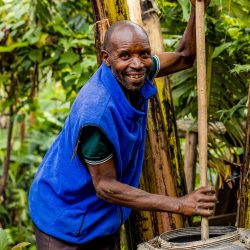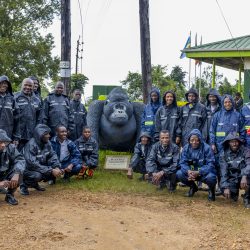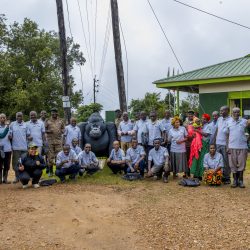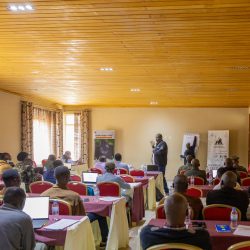Experiencing Conservation through RBM (Ranger-Based Monitoring)
Blog | 26/08/11
A key tool for the conservation of mountain gorillas and their montane habitat is Ranger Based Monitoring (RBM). We are Patrick and Louise, two zoology students from Newcastle University, UK, and we spent two weeks in Rwanda with IGCP experiencing conservation of a critically-endangered species and important habitat through RBM.
RBM is a simple and cost effective method for collecting data, used to monitor ecosystems and help make park management decisions. We were able to view RBM from many different perspectives- we met park rangers, trackers and staff from the Rwanda Development Board, local community members, and gained the perspective of an NGO while staying with IGCP. We found Ranger Based Monitoring to work like a well-oiled machine, systematic and functional in often complex circumstances.
RBM has evolved as a basic tool to collect information about the Mountain Gorillas; with the aim being a cost effective method to collect the maximum amount of information without the need for a large increase in manpower. RBM helped create family group profiles and to know each individual gorilla systematically, facilitating ‘extreme conservation.’
RBM is used not only to develop gorilla-based tourism, but also as an information-rich law enforcement tool to reduce the amount of illegal activity in the park. This helps to protect the gorillas, and decrease the incidences of poaching and accidental capture. The data produced allows RDB to make informed decisions about the management of Volcanoes National Park, and to direct their efforts successfully and efficiently. It also shows how effective management strategies have been based on the continuous data collected.
During our first week in Rwanda, we got the chance to visit the gorillas ourselves when we went to trek the Amahoro group. We were walking through the park for around half an hour before we were met by a group of trackers, who then led us to the Amahoro group, including the silverback Ubumwe. We spent one hour with the gorillas, watching the babies play, the adults lying sleepily on the forest floor and saw how at ease they all were with not only the trackers, but also with us. While seeing the gorillas themselves was an incredible experience, we also gained insight into the key role trackers play in RBM.
Trackers from Volcanoes National Park spend all day with the gorillas, from when they wake up in the morning until they go to sleep at night. They collect a wide range of data; from the location of the gorillas to information on the demographics, health and behaviour of each gorilla group. This data has provided a greater understanding of the gorillas and their habitat, as well as close health monitoring, so that the veterinarians can intervene at the first sign of life-threatening illness or injury.
Another crucial role for the continued success of RBM, is played by the park rangers. These rangers, who risk their lives to protect the park and its critically endangered mountain gorillas, collect information on illegal activities within the park. These illegal activities are done to extract resources- snares set to capture bush meat, hives for beekeeping and the cutting down of bamboo. As well as protecting the park, the information rangers collect, especially GPS points, allow park management to ensure the whole park is covered and to direct patrols to critical areas. We spoke to a team of rangers directly, who informed us they had seen a significant reduction in the number of snares and other illegal activities in the park over the last few years. They said that collaboration with ex-poachers as well as a good partnership with the local government was key in making this possible; again highlighting the importance of bringing all aspects of RBM together in order to manage the park successfully.
As RBM has become an established tool in Mountain Gorilla conservation, its uses have expanded into the communities surrounding the park in an attempt to tackle human-wildlife conflicts. When animals such as buffalo or even the gorillas leave the park, members of local communities, trained by IGCP and the Rwanda Development Board, record important information such as the location, species and any damage done. This simple technique gives a picture of where and how often conflicts with local wildlife are taking place allowing potential solutions to be directed accordingly. By involving people from local communities, many of whom were at one time involved in poaching themselves, RBM provides an alternative to poaching and allows the local people to feel involved with gorilla conservation and conservation of Volcanoes National Park as a whole.
As we discovered more about RBM, we found ourselves surprised at how adaptable and fluid it can be. RBM has successfully overcome a number of potential problems, such as the transboundary nature of the Virunga Massif. It has taken tremendous amounts of collaboration to harmonise data collection and monitoring between the three countries- Rwanda, Uganda and Democratic Republic of Congo- which share the Virunga Massif. Furthermore, with the continued help of NGOs such as the International Gorilla Conservation Programme (IGCP) the Virunga Massif is better able to be considered as one area rather than as three separate and independent National Parks.
Learning about RBM gave us an important and valuable insight and understanding into how in situ conservation works in the real world compared with the theory learned in class. We were able to observe firsthand what is needed in order to create successful conservation strategies, and how community involvement is essential to the long-term success of conservation. The time we spent in Rwanda really opened our eyes to what conservation is really about, and while seeing the gorillas in the wild was a truly unforgettable experience, we learnt that it is the cooperation between government, NGOs and communities that determines the success of conservation projects.








